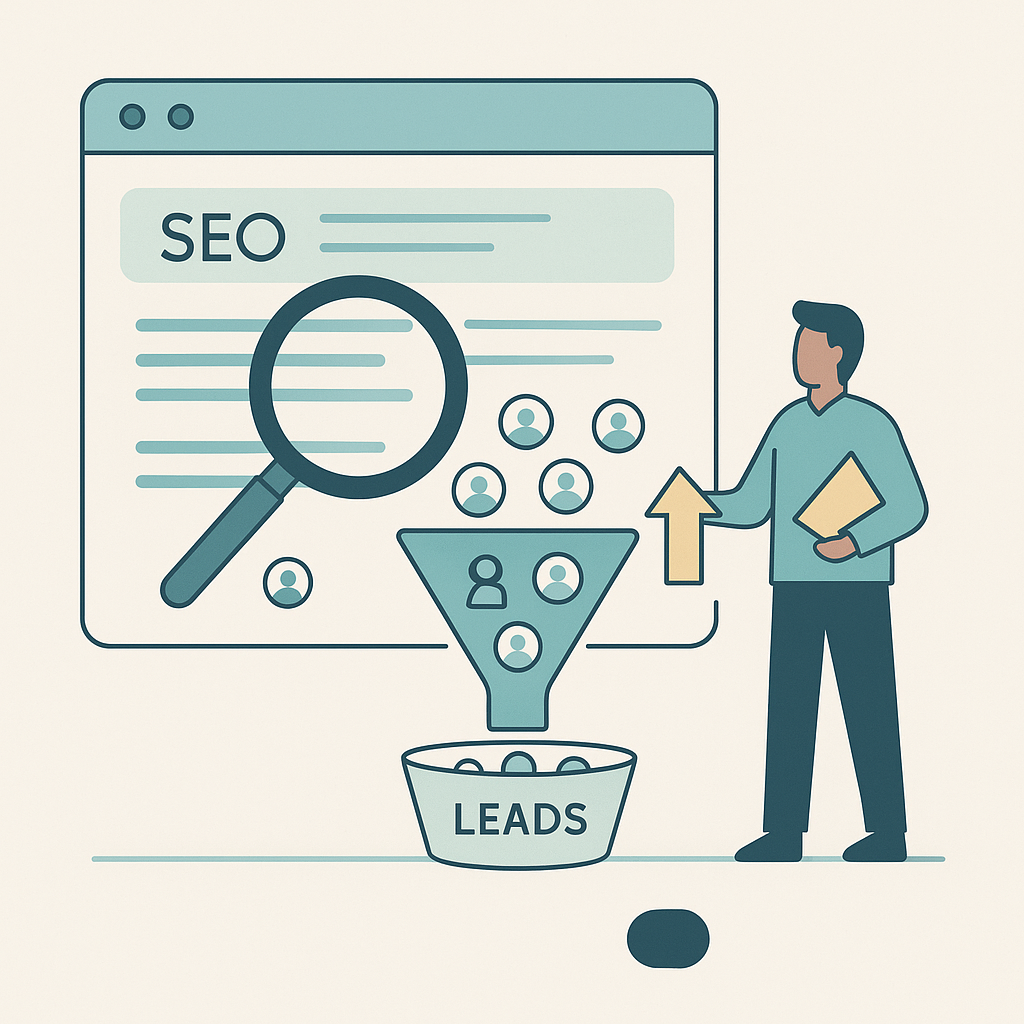Generating leads through content marketing is both an art and a science. While it’s essential to create engaging and valuable content, it’s equally important to align your strategies with lead generation goals. This article will explore effective strategies for content marketing that can help you generate and nurture leads.

Content marketing involves creating and sharing valuable content to attract and engage a target audience. Lead generation, on the other hand, is the process of attracting and converting prospects into potential customers. When combined, these two processes can significantly enhance your business growth.
The Symbiotic Relationship
Content marketing and lead generation are interconnected, each feeding into the success of the other. Content marketing provides the value and engagement necessary to attract leads, while lead generation focuses on converting that interest into tangible prospects. Understanding how these processes complement each other can help you craft more cohesive strategies.
Educating and Informing
Educating your audience through content is a cornerstone of lead generation. When you provide information that addresses their pain points or fulfills their curiosity, you establish authority in your industry. This educational aspect not only builds trust but also positions your brand as a go-to resource, increasing the likelihood of attracting potential leads.
Building Trust and Credibility
Building trust is a gradual process that content marketing can significantly accelerate. Consistently delivering high-quality and relevant content helps your audience see your brand as credible and reliable. This trust is crucial when it comes time for potential leads to make purchase decisions, as they are more likely to choose brands they trust.
Strategies for Content Marketing Lead Generation

Here are some effective strategies to enhance your content marketing efforts for lead generation:
1. Identify and Understand Your Audience
Knowing your audience is the first step in creating effective content. Start by developing buyer personas that include demographic information, interests, challenges, and needs. This understanding will help tailor your content to meet their expectations, making it more likely to generate leads.
Creating Detailed Buyer Personas
To effectively understand your audience, create detailed buyer personas. These personas should encompass various aspects such as age, gender, profession, and personal interests. More importantly, delve into their challenges and goals. By doing so, you can create highly targeted content that resonates with their specific needs.
Analyzing Audience Behavior
In addition to personas, analyze the behavior of your audience through analytics tools. Track metrics such as page views, time spent on pages, and click-through rates. This data provides insights into what content resonates most with your audience, allowing you to fine-tune your strategies for optimal engagement and lead conversion.
Segmenting Your Audience
Segmentation is another powerful technique in understanding your audience. Divide your audience into smaller groups based on common characteristics or behaviors. This segmentation allows for more personalized content delivery, increasing the likelihood of engaging your audience and converting them into leads.
2. Create High-Quality, Valuable Content
Ensure that your content is not only high-quality but also valuable to your audience. Focus on solving their problems and providing insights that they can’t find elsewhere. This will position your brand as an authority in your industry and build trust with potential leads.
Focusing on Problem-Solving Content
Create content that directly addresses the problems your audience faces. By offering solutions, you position your brand as a helpful resource. This problem-solving approach not only attracts attention but also builds a loyal audience base that trusts your expertise, making them more likely to convert into leads.
Providing Unique Insights
Offer insights that are unique to your brand. Whether through research, data analysis, or expert opinions, unique content differentiates you from competitors. This distinctiveness enhances your credibility and attracts an audience seeking fresh perspectives, ultimately boosting your lead generation efforts.
Consistency and Quality Control
Maintain a consistent content schedule while ensuring quality. Regularly publishing high-quality content keeps your audience engaged and coming back for more. Implement a quality control process to review and refine content before publishing, ensuring it meets your standards and continues to attract and convert leads.

3. Utilize SEO to Increase Visibility
Search Engine Optimization (SEO) is crucial for increasing the visibility of your content. Use target keywords like “content marketing lead generation” or “lead generation content marketing” strategically throughout your content. This will help improve your search engine rankings and drive more organic traffic to your site.
Keyword Research and Implementation
Conduct thorough keyword research to identify terms your audience is searching for. Implement these keywords naturally within your content, including titles, headings, and body text. A strategic approach to keyword placement can significantly enhance your content’s search engine visibility and attract more potential leads.
On-Page and Off-Page SEO Techniques
Optimize both on-page elements, such as meta tags and image alt texts, and off-page factors, like backlinks. On-page SEO ensures your content is easily accessible to search engines, while off-page SEO boosts your site’s authority. Together, these techniques enhance your overall SEO strategy, driving more traffic and potential leads.
Monitoring and Adjusting SEO Strategies
SEO is not a one-time effort; it requires constant monitoring and adjustment. Use analytics tools to track your content’s performance and identify areas for improvement. Regularly updating your SEO strategies ensures your content remains visible and continues to attract new leads over time.
4. Leverage LinkedIn for Professional Engagement
LinkedIn is a powerful platform for B2B lead generation. Share your content on LinkedIn to reach a professional audience. Participate in LinkedIn groups related to your industry, and engage with potential leads by providing insights and answering questions.
Crafting Engaging LinkedIn Content
Create content specifically tailored for LinkedIn’s professional audience. Share industry insights, case studies, and expert opinions to engage this demographic. By providing valuable content on LinkedIn, you position yourself as a thought leader, attracting professionals who could become potential leads. If you struggle with consistency or content ideas, platforms like Linkify support you by generating posts that sound like you, helping maintain visibility and nurture leads through genuine engagement.
Engaging in LinkedIn Groups
Join and participate in LinkedIn groups relevant to your industry. These groups are fertile ground for networking and lead generation. By actively contributing to discussions and offering valuable insights, you can connect with professionals interested in your expertise, thereby increasing your lead pool.
Utilizing LinkedIn Ads for Targeted Reach
Consider using LinkedIn Ads to reach a broader yet targeted audience. LinkedIn’s ad platform allows for precise targeting based on job titles, industries, and company sizes. This targeting capability ensures your content reaches the most relevant audience, enhancing your chances of lead generation.
5. Offer Lead Magnets
Lead magnets are incentives offered in exchange for contact information. Examples include ebooks, whitepapers, webinars, or exclusive access to content. By offering valuable lead magnets, you can encourage visitors to share their contact details, converting them into leads.
Designing Irresistible Lead Magnets
Create lead magnets that are not only valuable but also irresistible to your audience. Focus on providing content that addresses specific pain points or offers unique insights. An enticing lead magnet can significantly increase your conversion rates, effectively turning visitors into leads.
Promoting Lead Magnets Strategically
Strategically promote your lead magnets across various channels, including your website, social media, and email campaigns. Use compelling CTAs to draw attention to your offers, ensuring maximum visibility and engagement. A well-promoted lead magnet can attract a steady stream of potential leads.
Measuring Lead Magnet Effectiveness
Regularly assess the effectiveness of your lead magnets through metrics such as download rates and conversion rates. Analyzing these metrics helps you understand what works and what doesn’t, allowing you to refine your lead magnet strategy for better results over time.

6. Use Calls-to-Action (CTAs)
Incorporate clear and compelling calls-to-action in your content. CTAs guide your audience on what to do next, whether it’s downloading a resource, signing up for a newsletter, or contacting your sales team. Make sure your CTAs are aligned with your lead generation goals.
Crafting Compelling CTAs
Design CTAs that are not only clear but also compelling. Use action-oriented language and create a sense of urgency to encourage immediate responses. A good call to action can boost your conversion rates. It helps guide your audience to take the actions you want.
Placing CTAs Strategically
Place CTAs strategically within your content to maximize their effectiveness. Position them at the end of blog posts, within videos, or on landing pages where engagement is highest. Placing your CTAs in the right spots helps people notice and respond to them. This improves your chances of getting more leads.
Testing and Optimizing CTAs
Continually test and optimize your CTAs for better performance. Experiment with different wording, designs, and placements to see what resonates best with your audience. Regular optimization ensures your CTAs remain effective, driving consistent lead conversion.
7. Repurpose Content Across Multiple Channels
Repurposing content allows you to reach a wider audience. For example, turn a blog post into a video or infographic, and share it on different platforms. This strategy increases your content’s lifespan and maximizes its lead generation potential.
Transforming Content into Various Formats
Convert existing content into various formats such as videos, podcasts, and infographics. Each format appeals to different audience preferences, allowing you to reach a broader demographic. This diversification maximizes your content’s impact, increasing its potential to generate leads.
Distributing Content Across Platforms
Share repurposed content across multiple platforms to extend its reach. Each platform has its unique audience, and distributing content widely increases its visibility. By reaching more people, you enhance your chances of attracting new leads from diverse channels.
Evaluating Repurposed Content Performance
Assess the performance of your repurposed content through engagement metrics such as views, shares, and conversion rates. Understanding how different formats perform helps you refine your content strategy, focusing on formats that generate the most leads.
8. Engage with Interactive Content
Interactive content like quizzes, polls, and surveys can engage your audience more effectively than static content. It encourages participation and provides valuable insights into your audience’s preferences and needs, helping you tailor future content for better lead generation.
Designing Engaging Interactive Content
Create interactive content that captivates your audience. Ensure it is not only entertaining but also informative, providing value while engaging users. Engaging interactive content enhances user experience, increasing the likelihood of lead conversion.
Utilizing Interactive Content for Data Collection
Use interactive content to gather valuable data about your audience. Quizzes and surveys can provide insights into user preferences and behaviors. This data helps you tailor your content strategy, ensuring future efforts are more aligned with audience needs and more effective in generating leads.
Promoting Interactive Content for Maximum Engagement
Promote your interactive content through social media, email newsletters, and your website. Use eye-catching visuals and compelling CTAs to draw attention. Effective promotion ensures maximum engagement, increasing the chances of converting interactions into leads.
Measuring the Success of Your Content Marketing Efforts

To ensure your strategies are effective, it’s vital to measure the success of your content marketing efforts. Use metrics such as website traffic, conversion rates, and engagement levels to check your performance. Analyzing these metrics will help you refine your strategies for better results.
Key Performance Indicators (KPIs) to Track
- Website Traffic: Monitor the number of visitors to your site and their behavior.
- Lead Conversion Rates: Track how many visitors become leads.
- Engagement Levels: Measure how users interact with your content, including shares, likes, and comments.
Tracking Website Traffic and Behavior
Use tools like Google Analytics to track website traffic and user behavior. These insights can help you understand what content attracts visitors and how they navigate your site. Monitoring traffic patterns allows you to optimize your content strategy for better lead generation.
Analyzing Lead Conversion Rates
Examine your lead conversion rates to understand the effectiveness of your content in turning visitors into leads. Identify which pieces of content have the highest conversion rates and analyze what makes them successful. This analysis helps you use successful strategies in your content marketing.
Monitoring User Engagement Levels
Evaluate user engagement through metrics such as social media shares, likes, and comments. High engagement levels indicate that your content resonates with your audience. By understanding what drives engagement, you can refine your content strategy to foster deeper connections and generate more leads.
Conclusion
Content marketing is a powerful tool for lead generation when done correctly. By understanding your audience, creating valuable content, and implementing effective strategies, you can attract and convert leads more efficiently.
Keep refining your approach based on performance metrics, and stay updated with the latest trends in content marketing to maintain a competitive edge. Regularly reviewing and adjusting your strategies will help you keep finding and growing leads.
